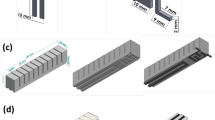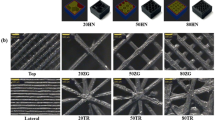Abstract
The research aims to develop an affordable, user-friendly composite material with mechanical flexibility, durability, and wear-resistant properties for soft actuation to maintain its functionality and performance over time. In order to reach this goal, the experimental activities were specific into the following tasks: (a) material pre-selection, (b) design of the experiment, (c) specimen preparation (extrusion process), and (d) mechanical properties and material characterization. This research explores the utilization of regular thermoplastic polyurethane (TPU) in combination with electric-conductive thermoplastic polyurethane (TPU/E-TPU) to achieve enhanced flexibility and electrical conductivity. However, there is no doubt that composite materials are advanced materials with superior properties. The composite material is robust than both TPU and E-TPU in terms of its mechanical properties. It has the highest flexural strength 62 MPa, modulus 2.7 GPa, tensile strength 38 MPa, modulus 2.9 GPa, and fracture strain (480%). However, E-TPU and TPU represent a measured flexural strength of 35 MPa, indicating a similar level of strength. The SEM–EDS and microstructural analyses show excellent mechanical act of the composite. Carbon-based compounds (38% atomic C, 35% weight C) improve mechanical strength, stiffness, and robustness. Meanwhile, TPU’s polymer matrix uses oxygen (36% atomic, 44% weight) and boron (26% atomic, 21% weight) can enhance such characteristics, which is suitable for soft robotics, wearable electronics, aerospace, medical devices, and other manufacturing applications requiring flexible movement.











Similar content being viewed by others
Data availability
The data presented in this study are available on request from the corresponding author.
References
Abdullah AM, Li X, Braun PV et al (2020) Kirigami-inspired self-assembly of 3D structures. Adv Funct Mater 30:. https://doi.org/10.1002/adfm.201909888
Ning X, Wang X, Zhang Y et al (2018) Assembly of advanced materials into 3D functional structures by methods inspired by origami and kirigami: a review. Adv Mater Interfaces 5
Yu C, Duan Z, Yuan P et al (2013) Electronically programmable, reversible shape change in two- and three-dimensional hydrogel structures. Adv Mater 25:. https://doi.org/10.1002/adma.201204180
Aoki M, Juang JY (2018) Forming three-dimensional closed shapes from two-dimensional soft ribbons by controlled buckling. R Soc Open Sci 5:. https://doi.org/10.1098/rsos.171962
Song E, Li J, Won SM et al (2020) Materials for flexible bioelectronic systems as chronic neural interfaces. Nat Mater 19:590–603. https://doi.org/10.1038/s41563-020-0679-7
Ghaffari R, Choi J, Raj MS et al (2020) Soft wearable systems for colorimetric and electrochemical analysis of biofluids. Adv Funct Mater 30. https://doi.org/10.1002/adfm.201907269
Yeh CY, Chen CY, Juang JY (2020) Soft hop** and crawling robot for in-pipe traveling. Extrem Mech Lett 39:. https://doi.org/10.1016/j.eml.2020.100854
Bhat A, Ambrose JW, Yeow RCH (2023) Composite soft pneumatic actuators using 3D printed skins. IEEE Robot Autom Lett 8:. https://doi.org/10.1109/LRA.2023.3246841
Li S, Bai H, Shepherd RF, Zhao H (2019) Bio-inspired design and additive manufacturing of soft materials, machines, robots, and haptic interfaces. Angew Chemie - Int Ed 58:11182–11204. https://doi.org/10.1002/anie.201813402
Cho KJ, Koh JS, Kim S et al (2009) Review of manufacturing processes for soft biomimetic robots. Int J Precis Eng Manuf 10:171–181. https://doi.org/10.1007/s12541-009-0064-6
Walker S, Yirmibeşoğlu OD, Daalkhaijav U, Mengüç Y (2019) Additive manufacturing of soft robots. In: Robotic systems and autonomous platforms. Elsevier, pp 335–359. https://doi.org/10.1016/b978-0-08-102260-3.00014-7
Schmitt F, Piccin O, Barbé L, Bayle B (2018) Soft robots manufacturing: a review. Front Robot AI 5:84. https://doi.org/10.3389/frobt.2018.00084
Rus D, Tolley MT (2015) Design, fabrication and control of soft robots. Nature 521:467–475. Retrieved from https://doi.org/10.1038/nature14543%5Cn
Wu WZ, Geng P, Zhao J et al (2014) Manufacture and thermal deformation analysis of semicrystalline polymer polyether ether ketone by 3D printing. Mater Res Innov 18:. https://doi.org/10.1179/1432891714Z.000000000898
Bernard A, Fischer A (2002) New trends in rapid product development. CIRP Ann - Manuf Technol 51:. https://doi.org/10.1016/S0007-8506(07)61704-1
Gebhardt A (2011) Understanding additive manufacturing: rapid prototy** - rapid tooling - rapid manufacturing. Carl Hanser, München, p 591. Postfach. Retrieved from http://www.sciencedirect.com/science/article/pii/B9783446425521500021
Masood SH (1996) Intelligent rapid prototy** with fused deposition modelling. Rapid Prototyp J 2:. https://doi.org/10.1108/13552549610109054
Onwubolu GC, Rayegani F (2014) Characterization and optimization of mechanical properties of ABS parts manufactured by the fused deposition modelling process. Int J Manuf Eng 2014:. https://doi.org/10.1155/2014/598531
Nancharaiah T, Raju D, Raju V (2010) An experimental investigation on surface quality and dimensional accuracy of FDM components. J Emerg Technol 1:106–111
Türk DA, Brenni F, Zogg M, Meboldt M (2017) Mechanical characterization of 3D printed polymers for fiber reinforced polymers processing. Mater Des 118:. https://doi.org/10.1016/j.matdes.2017.01.050
Aurilia M, Piscitelli F, Sorrentino L, et al (2011) Detailed analysis of dynamic mechanical properties of TPU nanocomposite: the role of the interfaces. Eur Polym J 47:. https://doi.org/10.1016/j.eurpolymj.2011.01.005
Ma H, Yang Y (2008) Rheology, morphology and mechanical properties of compatibilized poly(vinylidene fluoride) (PVDF)/thermoplastic polyurethane (TPU) blends. Polym Test 27:. https://doi.org/10.1016/j.polymertesting.2008.01.009
Li W, Liu J, Hao C et al (2008) Interaction of thermoplastic polyurethane with polyamide 1212 and its influence on the thermal and mechanical properties of TPU/PA1212 blends. Polym Eng Sci 48:. https://doi.org/10.1002/pen.20853
Mi HY, Salick MR, **g X et al (2013) Characterization of thermoplastic polyurethane/polylactic acid (TPU/PLA) tissue engineering scaffolds fabricated by microcellular injection molding. Mater Sci Eng C 33:. https://doi.org/10.1016/j.msec.2013.07.037
Poomali, Siddaramaiah, Suresha B, Lee JH (2008) Mechanical and three-body abrasive wear behaviour of PMMA/TPU blends. Mater Sci Eng A 492:. https://doi.org/10.1016/j.msea.2008.03.018
Feng F, Ye L (2011) Morphologies and mechanical properties of polylactide/thermoplastic polyurethane elastomer blends. J Appl Polym Sci 119:. https://doi.org/10.1002/app.32863
Lu QW, Macosko CW, Horrion J (2003) Compatibilized blends of thermoplastic polyurethane (TPU) and polypropylene. In: Macromolecular Symposia, 198:221–232. https://doi.org/10.1002/masy.200350819
Lee H, Eom RI, Lee Y (2019) Evaluation of the mechanical properties of porous thermoplastic polyurethane obtained by 3D printing for protective gear. Adv Mater Sci Eng 2019:. https://doi.org/10.1155/2019/5838361
Bates SRG, Farrow IR, Trask RS (2016) 3D printed polyurethane honeycombs for repeated tailored energy absorption. Mater Des 112:. https://doi.org/10.1016/j.matdes.2016.08.062
Li Y, Zhou B, Zheng G, et al (2018) Continuously prepared highly conductive and stretchable SWNT/MWNT synergistically composited electrospun thermoplastic polyurethane yarns for wearable sensing. J Mater Chem C 6:. https://doi.org/10.1039/c7tc04959e
Scarpello ML, Kazani I, Hertleer C, et al (2012) Stability and efficiency of screen-printed wearable and washable antennas. IEEE Antennas Wirel Propag Lett 11:. https://doi.org/10.1109/LAWP.2012.2207941
Wang X, Guo R, Liu J (2019) Liquid metal based soft robotics: materials, designs, and applications. Adv Mater Technol 4
Zhu J, Lyu L, Xu Y et al (2021) Intelligent soft surgical robots for next‐generation minimally invasive surgery. Adv Intell Syst 3:. https://doi.org/10.1002/aisy.202100011
Kakizaki S, Shintake J, Iwatake Y et al (2020) Large, fast, and bidirectional bending of slide‐ring polymer materials. Adv Intell Syst 2:. https://doi.org/10.1002/aisy.201900155
Yang J, Cheng W, Kalantar-Zadeh K (2019) Electronic skins based on liquid metals. Proc. IEEE 107
Zhou Y, Wan C, Yang Y et al (2019) Highly stretchable, elastic, and ionic conductive hydrogel for artificial soft electronics. Adv Funct Mater 29:. https://doi.org/10.1002/adfm.201806220
Guo R, Sun X, Yao S et al (2019) Semi-liquid-metal-(Ni-EGaIn)-based ultraconformable electronic tattoo. Adv Mater Technol 4:. https://doi.org/10.1002/admt.201900183
Park S, Baugh N, Shah HK et al (2019) Ultrastretchable elastic shape memory fibers with electrical conductivity. Adv Sci 6:. https://doi.org/10.1002/advs.201901579
Gao W, Ota H, Kiriya D et al (2019) Flexible electronics toward wearable sensing. Acc Chem Res 52:. https://doi.org/10.1021/acs.accounts.8b00500
Nie S, Hao N, Zhang K et al (2020) Cellulose nanofibrils-based thermally conductive composites for flexible electronics: a mini review. Cellulose 27:4173–4187. https://doi.org/10.1007/s10570-020-03103-y
Yang M, Xu Y, Zhang X et al (2022) Bioinspired phototropic MXene-reinforced soft tubular actuators for omnidirectional light-tracking and adaptive photovoltaics. Adv Funct Mater 32:. https://doi.org/10.1002/adfm.202201884
Yang J, Zhang X, Zhang X et al (2021) Beyond the visible: bioinspired infrared adaptive materials. Adv. Mater. 33
Zhang X, Yang Y, Xue P et al (2022) Three-dimensional electrochromic soft photonic crystals based on MXene-integrated blue phase liquid crystals for bioinspired visible and infrared camouflage. Angew Chemie - Int Ed 61:. https://doi.org/10.1002/anie.202211030
Brancewicz-Steinmetz E, Sawicki J, Byczkowska P (2021) The influence of 3d printing parameters on adhesion between polylactic acid (Pla) and thermoplastic polyurethane (tpu). Materials (Basel) 14:. https://doi.org/10.3390/ma14216464
Gorlachova M, Mahltig B (2021) 3D-printing on textiles – an investigation on adhesion properties of the produced composite materials. J Polym Res 28:. https://doi.org/10.1007/s10965-021-02567-1
Majidi C (2014) Soft robotics: a perspective - current trends and prospects for the future. Soft Robot 1:5–11. https://doi.org/10.1089/soro.2013.0001
Yap YL, Sing SL, Yeong WY (2020) A review of 3D printing processes and materials for soft robotics. Rapid Prototyp J 26:23–30
Lozano AB, Álvarez SH, Isaza CV, Montealegre-Rubio W (2022) Analysis and advances in additive manufacturing as a new technology to make polymer injection molds for world-class production systems. Polymers (Basel) 14
Dudescu C, Racz L (2017) Effects of raster orientation, infill rate and infill pattern on the mechanical properties of 3D printed materials. ACTA Univ Cibiniensis 69:. https://doi.org/10.1515/aucts-2017-0004
Watschke H, Waalkes L, Schumacher C, Vietor T (2018) Development of novel test specimens for characterization of multi-material parts manufactured by material extrusion. Appl Sci 8:. https://doi.org/10.3390/app8081220
Funding
This work was financially supported by Industrial Technology Research and Development Project of Jilin Province 2022C040-9; Jilin University Graduate Education Teaching Reform Project 2021JGZ24; Key project of Education Department of Jilin Province JJKH20231147KJ.
Author information
Authors and Affiliations
Contributions
The authors solely contributed to the manuscript. Moreover, we acknowledge Professor Wenzheng Wu (W. Wu) for his essential guidance throughout the writing process. All authors have read and agreed to the published version of the manuscript.
Corresponding author
Ethics declarations
Competing interests
The authors declare no competing interests.
Additional information
Publisher's Note
Springer Nature remains neutral with regard to jurisdictional claims in published maps and institutional affiliations.
Rights and permissions
Springer Nature or its licensor (e.g. a society or other partner) holds exclusive rights to this article under a publishing agreement with the author(s) or other rightsholder(s); author self-archiving of the accepted manuscript version of this article is solely governed by the terms of such publishing agreement and applicable law.
About this article
Cite this article
Farid, M.I., Wu, W., Li, G. et al. Research on 3D printing composite material mechanical characterization of robust soft-matter robots. Int J Adv Manuf Technol (2024). https://doi.org/10.1007/s00170-024-13725-2
Received:
Accepted:
Published:
DOI: https://doi.org/10.1007/s00170-024-13725-2




